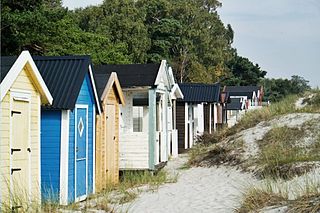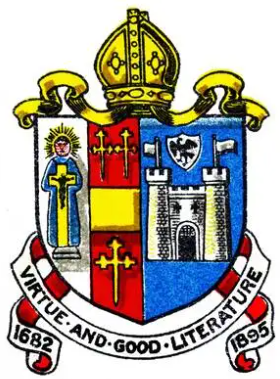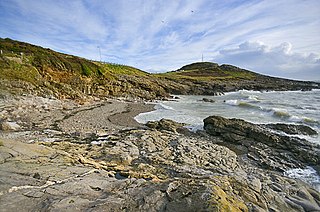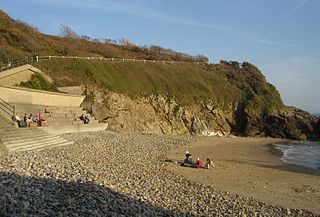Langland Bay is a popular coastal holiday resort in Gower, Swansea in south Wales. It is a popular surfing beach which regularly meets the European Blue Flag award for quality.
Contents

| Gower |
|---|
 |
Langland Bay is a popular coastal holiday resort in Gower, Swansea in south Wales. It is a popular surfing beach which regularly meets the European Blue Flag award for quality.

| Gower |
|---|
 |
Langland Bay - together with Caswell Bay, Rotherslade, Limeslade Bay, Bracelet Bay and Port Eynon - is managed by the City and County of Swansea council. Because of their relative proximity to Swansea and the South Wales Valleys, Langland Bay and Caswell Bay in particular were extremely popular in the 1950s and 60s with holiday visitors, who would arrive by coach or by public transport. In summer months the sea front serviced by the South Wales Transport bus route 87; at other times of the year, a walk was necessary from Langland Corner, at the top of Langland Bay Road.
The sea front of Langland and the adjacent Rotherslade, or 'Little Langland' as it is sometimes known, were once the location for three hotels: the Langland Bay, the Ael-y-Don, and the Osborne; and three further hotels - the Brynfield Hotel, the Langland Court, and the Wittemberg - were located in the immediate hinterland. All bar one have closed over the past forty years, and have been replaced with apartments (Langland Bay, Osborne and Ael-y-don), converted to a nursing home (Brynfield), closed and subjected to arson attacks (Langland Court and, previously, the Osborne). The Wittemberg was partially demolished and re-opened in its original Victorian core as the Little Langland Hotel.
By far the most dominant building, built in the mid-nineteenth century and backing on to the Newton Cliffs, was originally known as Llan-y-Llan. Built in the Scottish Baronial style by the Crawshay family, the Merthyr Tydfil Ironmasters, it was used as their summer residence. In the first part of the 20th century it later became part of the Langland Bay Hotel, and later again the Club Union Convalescent Home for coal miners. After a period of closure it has been renamed Langland Bay Manor and been converted into 13 luxury apartments.
In 1897 the French Impressionist painter Alfred Sisley made two watercolours of Langland Bay, while on honeymoon. He was staying at the Osborne Hotel, which overlooked both Langland Bay and Rotherslade Bay. Over twenty paintings resulted from his visit to Penarth and the Gower. Two of them are now in the National Museum of Wales in Cardiff. [1]
As well as the beach huts that still exist, Langland Bay was famous for its 'community' of green canvas beach tents. These were erected annually, usually between April and early September, on the stoney storm beach in front of the promenade. A local spectacle was the early September 'spring tide watch' when rough seas would occasionally cause the loss of one or two. Somewhat safer and more sheltered on the higher ground of the Langland Bay Golf Club, [2] a further two rows of tents were permitted. All succumbed to vandalism in the 1970s.
Langland Bay has always been the site of sports innovation. Every year in the early 1960s saw local teenagers becoming amongst the first in the country to take up American innovations such as skateboarding, surfing, and fibreglass canoes; which overtook their parents` use of canvas sea-going canoes.
A coastal path links Langland Bay to Caswell Bay to the west and to Rotherslade, Limeslade Bay and Bracelet Bay to the east. The bay is accessible by road, and is serviced by public transport for a short period during the school summer holidays; there are also two large Pay-&-Display car-parks. Hot and cold snacks are available from two small shops, though these tend to operate limited opening times during the winter and focus on ice-creams and gifts for children. Public showers are available near the beach, and a St John's Ambulance Hut and Information Office operate at peak times.
Swansea City Council operate a Surf Lifeguard service at the beach from the end of May to the beginning of September.
The beach currently hosts around 80 Council-owned holiday beach huts which are rented out for variable periods. The oldest of these were originally built in 1923, but a group of 12 at the western end of the Bay were built in the early 1960s. Over the years most had been gradually falling into a sorry state of repair, with at least one lost to an arson attack, but in 2007 reconstruction of them all was begun. At the eastern end of the Bay are a number of privately owned beach huts within their own grounds and gated car park.
Also at the western end of the beach promenade is a brasserie, which opened in the summer of 2007. This replaced an old tea shop and ice-cream parlour of a similar age to the original beach huts.
Six tennis courts can be hired by the public. These have been the location in recent years for the popular Swansea Junior Tennis Championships supported by Swansea City Council. (In the 1960s the courts hosted a similar tournament but covered a wider age range.)
The course of Langland Bay Golf Club overlooks the bay from the west, and has great views of Langland Bay and Caswell Bay. The 18-hole course is relatively short, with a standard scratch score of 70. However, the tightness of the course is enough to challenge any golfer, and unpredictable winds from the exposed headland can often affect the game.
Langland Bay is popular with surfers, as it is conveniently located near residential areas and because of the variety of waves that can be ridden at different tide levels.
At low tide, Crab Island provides one of the best-shaped and most powerful right-hand waves in the country; however, many are put off by the fact that the wave breaks onto the exposed reef, so it is considered dangerous for novice surfers. The sandbar situated offshore between Langland Point and Crab Island is actually a reef, which creates a powerful and dangerous wave breaking in shallow water. Langland Point offers a more gentle wave on days when the swell is large.
At mid-tide the reef (which is more secluded from the main swell) provides a smaller but crowded wave.
At very high tide the shore-break deposits unwary surfers directly onto stones.
Several local surfers have competed on an international level, most notably Carwyn Williams, whose parents ran a small hotel in the resort. Carwyn Williams once beat Australian Damien Hardman, the World champion at the time, in Hossegor, France. Shortly after this he endured a horrific car crash, doctors telling him he would not walk again. He is now living and surfing in France after making a full recovery.
Fishing is not commonly practised in Langland these days, either from the beach or from the rocky shore. A strikingly marked large rock on the western side of the bay called Cross Rock used to be a popular spot to fish at high tide in the summer months with float and soft crab as bait. Catches included bass, sea bream and dogfish. Langland Point held similar promise, but the use of spinners or feathers here sometimes delivered mackerel as well as bass. Occasional Common dab and European plaice were caught with lugworm or ragworm from the beach, although the worm population of the beach has always been small.

Gower or the Gower Peninsula is in South West Wales and is the most westerly part of the historic county of Glamorgan, Wales. It projects towards the Bristol Channel. In 1956, the majority of Gower became the first area in the United Kingdom to be designated an Area of Outstanding Natural Beauty.

The Bristol Channel is a major inlet in the island of Great Britain, separating South Wales and South West England. It extends from the smaller Severn Estuary of the River Severn to the North Atlantic Ocean. It takes its name from the English city and port of Bristol.

Swansea Bay is a bay on the southern coast of Wales. The River Neath, River Tawe, River Afan, River Kenfig and Clyne River flow into the bay. Swansea Bay and the upper reaches of the Bristol Channel experience a large tidal range. The shipping ports in Swansea Bay are Swansea Docks, Port Talbot Docks and Briton Ferry wharfs.

Three Cliffs Bay, otherwise Three Cliff Bay, is a bay on the south coast of the Gower Peninsula in the City and County of Swansea, Wales. The bay takes its name from the three sea cliffs that jut out into the bay. Pennard Pill, a large stream, flows into the sea in the middle of the bay.

Rhossili is both a small village and a community on the southwestern tip of the Gower Peninsula in Wales. It is within the first Area of Outstanding Natural Beauty in the United Kingdom. The village has a community council and is part of the Gower parliamentary constituency, and the Gower electoral ward. At the 2011 census, the population was 278. The community includes the hamlet of Middleton.

Cardiff-by-the-Sea, usually referred to as Cardiff, is a beach community in the incorporated city of Encinitas in San Diego County, California. The Pacific Ocean is to the west of Cardiff-by-the-Sea, the rest of incorporated Encinitas is to the east and north, and a beach and lagoon to the south. With a population of under 12,000, Cardiff-by-the-Sea operates as part of the city of Encinitas, but unlike the other communities that comprise Encinitas, has its own ZIP code (92007). Cardiff is home to a few well-known surf spots, such as Swami's and Cardiff Reef.

A beach hut is a small, usually wooden and often brightly coloured, box above the high tide mark on popular bathing beaches. They are generally used as a shelter from the sun or wind, changing into and out of swimming attire and for the safe storing of some personal belongings. Some beach huts incorporate simple facilities for preparing food and hot drinks by either bottled gas or occasionally mains electricity.

Newton is a village in the city of and County of Swansea, Wales. The village is located near the Mumbles just inland and uphill from Swansea Bay. The Newton ward was a part of the Mumbles community.

Bishopston is a large village and community situated on the Gower Peninsula, 6 miles (9.7 km) west south west of the centre of Swansea in South Wales.

The Bishop Gore School is a secondary school in Swansea in Wales, founded on 14 September 1682 by Hugh Gore (1613–1691), Bishop of Waterford and Lismore. It is situated in Sketty, close to Singleton Park and Swansea University. In December 2013 the school was ranked in the second highest of five bands by the Welsh Government, based on performance in exams, value added performance, disadvantaged pupils' performance, and attendance.
G-Land, also known as Plengkung Beach, is an internationally renowned surf break on Grajagan Bay, Banyuwangi, Alas Purwo National Park, East Java, Indonesia, about half a day by road from the popular tourist destinations of Bali. It is most commonly reached via boat charter from Bali.

Caswell Bay, is a beach on the south east of the Gower Peninsula, Swansea, Wales. It is a sandy beach popular with families, holiday makers and surfers, and it regularly achieves Blue Flag status.

Limeslade Bay is a small cove just to the west of Bracelet Bay in the south east corner of the Gower Peninsula, near Swansea in south Wales. It is a sheltered, mainly rocky beach with little sand. Bathing is possible. There is a car park in the adjacent Bracelet Bay. From Limeslade Bay there is a cliff walk to Langland Bay, about half a mile to the west.

Rotherslade is a small stretch of sandy beach at the eastern end of Langland Bay in the south Gower Peninsula, Wales. Previously known as 'Little Langland', it only exists as a separate beach at high tide. At low tide it is continuous with Langland Bay.

The Mumbles is a district of Swansea, Wales, located on the south-east corner of the unitary authority area. It is also a local government community using the same name. At the 2001 census the population was 16,774, reduced slightly to 16,600 at the 2011 Census. The district is named after the headland of Mumbles, located on its south-east corner.

A surf break is a permanent obstruction such as a coral reef, rock, shoal, or headland that causes a wave to break, forming a barreling wave or other wave that can be surfed, before it eventually collapses. The topography of the seabed determines the shape of the wave and type of break. Since shoals can change size and location, affecting the break, it takes commitment and skill to find good breaks. Some surf breaks are quite dangerous, since the surfer can collide with a reef or rocks below the water.

The North Shore, in the context of geography of the Island of Oʻahu, refers to the north-facing coastal area of Oʻahu between Kaʻena Point and Kahuku. The largest settlement is Haleʻiwa.

The beaches in Póvoa de Varzim are an extensive and continuous group of golden sandy beaches forming small bays or coves along the shoreline in northern Portugal. These do not have any barrier and are in fact a single beach, over 12 km long, under the name Praia da Póvoa de Varzim. Division may be arbitrary and serve localization porpoises.

Long Reef is a prominent headland on the Northern Beaches of Sydney, Australia. Connected to the mainland by a tombolo, the reef has an extensive wave-cut platform. Long Reef is a popular recreational destination and is one of the more interesting geological areas in Sydney.